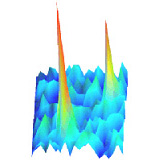Rick joined our team as PhD student to investigate the role of mechanics and forces in metastasis. The project is embedded in a research program sponsored by an NWO EW-groot grant.
Characterization of the Role of Cellular Forces in Cancer Metastases.
Genetic programs driving metastasis of solid tumors vary between cancer types and even between people carrying the same cancer type. Nevertheless, the ultimate outcome is shared: cancer cells are empowered to pass a series of physical hurdles to escape the original tumor and disseminate to other organs. Accumulating evidence suggests that metastasis in most cases involves collective cell behavior whereby cell clusters pass these hurdles more successfully than individual cancer cells. This collective advantage is not understood. In recent years, “active matter” has emerged as a new paradigm to describe collective behavior across length scales: from bird flocks down to artificial self-propelled particles. This paradigm was recently found to describe cellular collectivity in biological processes like embryonic development and wound healing with surprising accuracy. We will develop and experimentally test a new theoretical framework based on concepts from active matter physics to understand how the collective behavior of cancer cells drives the early stages of metastasis. Multiscale theoretical models will be combined with in vitro and in vivo experimental biology and biophysics to unravel how motile clusters originate and dissociate from the primary tumor; how they navigate the mechanically complex environment as they invade surrounding tissues; and how they enter the blood stream to spread to distant organs. Our program identifies the key physical determinants of the early steps leading to systemic metastasis, providing new handles for rational design of future cancer therapy targeting principles shared across solid tumors.
The PhD project will be involved in two of the main questions:
How do clusters form and dissociate? We study active unjamming of cells inside the primary tumor and the detachment of cell clusters, taking into account 3D extracellular matrix (ECM) confinement. This objective will provide us with insights in the mechanisms that control the emergence of cell clusters and set their initial shape and size distribution.
How do clusters intravasate? We study the impact of elastic and fluid stresses that cell clusters encounter as they traverse the vessel wall (intravasation). We will determine the relation between intravasation efficiency, cluster size and deformability, and investigate how entry into the vessel breaks up cell clusters. This objective will deliver a predictive understanding of how these processes set the size distribution, viability, and stability of metastatic cell clusters in the blood stream.

